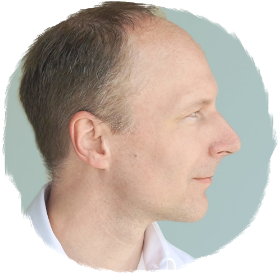So here’s my latest movement sequence lesson. Or at least… it was my latest, before I sketched out two more of them. Quite a productive morning I have to say. I will try to word this one out as concisely as possible, while retaining intelligibility and more importantly not to bore myself doing so. So here’s my sequence:
Starting position
Lie on your right side, legs bent, stand your left hand in front of your chest.
Reference movements
For later reference: Move your left shoulder forwards and also backwards. See what you do notice about these movements while doing them.
Shift awareness to the components of the movement
Now bring your attention to your nose, the tip of your nose. Roll your head as if you would like to approach the tip of your nose closer to the floor. But don’t touch, just move into that direction. Lower your nose towards the floor and distance it from the floor again, a couple of times. Observe how you do it, observe what you can discover, comprehend, learn about this movement.
Then bring your attention to your mouth. Roll your head as if to approach your mouth closer to the floor. Even more so, do it as you would like to touch your tongue to the floor. Of course, don’t actually touch your tongue to the floor, just aim into the direction. The floor is ice-cream. Try to find the most simple, most straightforward way.
Then bring your attention to the back of your head. Help with your hand: touch the back of your head with one of your hands. It’s not the top of the head, not the neck, but somewhere in between. It’s not a small area. Find the point that you would name the tip of the back of your head.
Then, with your left hand standing in front of you, roll your head to the right, by lifting the tip of the back of your head further away from the floor.
Combine movements and observe kinematic linkage
Bring your attention to your left shoulder again. Move your left shoulder forwards, observe whether or not your head is rolling to the right, your nose is approaching the floor and the back of your head is lifting away from it. Feel how your chest is rolling, how you roll over the right side of your chest. Observe whether or not your pelvis is rolling too, whether or not your left knee is sliding forwards or not.
Then reverse the direction, pull your left shoulder backwards.
Observe how changes in arm position influence the same movements
Then continue with these explorations of pushing and pulling and rolling, but rest your left arm in various positions: behind your back, downwards on your left side, upwards over or on your head.
Reference movements
Return to the reference movements from the beginning of the sequence: move your left shoulder forwards and backwards. Observe what has changed. Observe how your way of observing has changed. Going full blown meta here.
Rest on your back to give yourself the opportunity to perceive more differences, improvements, observations.
Now stand up and see how it is in standing.
Some notes
I put this sequence together from various building blocks, or elements. I have no name for them yet. Somatic elements? A simple, goal oriented, habitual rolling of the head becomes a mindful exploration, an experiment even: the attention is shifted to the tip of the nose, and bringing the nose closer to the floor, and at the same time the back of the head further away from the floor. This creates, or requires, a skilful process of observing several things at the same time, without reacting stressful over it. This is still a turn of the head, but now we have many things involved, including perceivable distances. How far is the tip of the nose away from the floor in every moment? We become conscious of how this movement is performed, and thus can improve the movement itself.
Could such an element be a lesson on its own? Should it be? Would this be the base for an extensive catalogue? What would the elements of such a catalogue be called? Movement-mini-games? Mini-lessons? Somatic elements? What would the criteria for inclusion and exclusion be? How would every element be indexed and tagged? What are the use cases?
On its own it would be a mini-lesson about how to turn the head. However, by connecting it to the next adjacent, significant structure, the shoulders, which in turn connect to the chest, which in turn connects to the pelvis… it becomes a lesson about turning the head in a more integrated way. „Integrated” means it doesn’t stand on its own but is part of the whole self. And thus the experience is deeper, more significant, more relevant.
This mini-lesson could be expanded even further. There could be additional elements in other, every day postures, for example in standing or sitting. It could be a build up to more functions such as reaching and pulling.
But then it’s not a small 10-15 minutes lesson anymore, then it’s a workshop with many lessons, maybe even an entire training course. My hypothetical questions remain: what does qualify as a somatic movement element? What are the brush-strokes, styles and colours of a lessons? When do we need to add more, and when should (or could) we stop?

